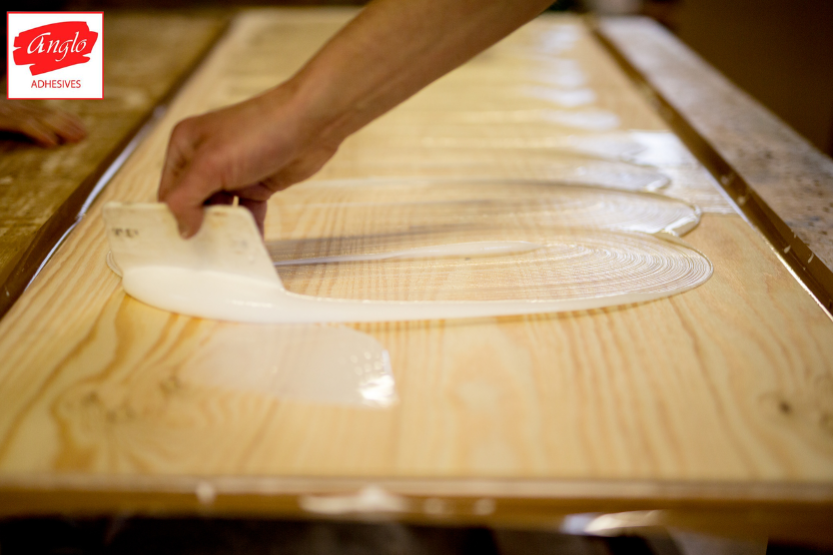Blog
What is Wood Adhesive for Carpentry and Woodworking?

For centuries, carpentry and woodworking have relied on meticulous craftsmanship and strong joints to create beautiful and functional objects. While dovetail joints and mortise-and-tenon assemblies showcase remarkable skill, in modern woodworking, a seemingly simple yet powerful tool plays a vital role: wood adhesive. But what is wood adhesive, and how does it elevate the craft of woodworking?
What is Wood Adhesive?
Wood adhesive, also commonly called wood glue or carpenter’s glue, is a substance that creates a strong bond between two or more wood surfaces. Available in various forms—liquids, gels, and even sprays—wood adhesives come into play in a multitude of woodworking projects, from simple furniture assembly to intricate marquetry work.
The Science Behind the Bond: How Does Wood Adhesive Work?
So, how does this seemingly ordinary substance achieve such remarkable results? Most wood adhesives are based on polymers, long chains of molecules that interlock when the adhesive dries. Here’s a straightforward explanation of the procedure:
- Application: The adhesive is applied to one or both wood surfaces, depending on the specific type and project requirements.
- Assembly: The prepared wood pieces are carefully joined together, ensuring proper alignment and contact between the glued surfaces.
- Clamping: Clamps are used to apply pressure, forcing the adhesive into the wood fibres and ensuring a strong bond. The specific clamping pressure and drying time can vary depending on the adhesive type.
- Curing: As the adhesive dries, the polymer chains solidify, creating a permanent bond between the wood pieces.
Choosing the Right Weapon: Types of Wood Adhesives
The world of wood adhesives is surprisingly diverse, with each type offering distinct properties and applications. Here’s a brief overview of several typical categories:
- Polyvinyl Acetate (PVA): The most widely used type, PVA glue is known for its ease of use, affordability, and strong bond for general woodworking projects. It comes in various subtypes, with some offering water resistance for applications like furniture exposed to occasional moisture.
- Polyurethanes (PU): These adhesives offer superior strength, water resistance, and gap-filling capabilities, making them ideal for outdoor projects, repairs, and applications with uneven surfaces.
- Natural Rubber-Based Adhesive: Offers a sustainable and eco-friendly alternative to traditional wood glues. Derived from latex, a renewable resource harvested from rubber trees, these adhesives boast some attractive qualities for specific woodworking applications. They often provide a strong initial bond, making them suitable for basic assembly tasks. Additionally, their natural elasticity can be beneficial in some woodworking applications where slight movement or vibration is expected.
- Water-borne Polychloroprene Adhesives: Offer a unique set of advantages for specific applications. They boast strong initial tack and adhesion, which can be beneficial for the quick assembly of pre-fit wood pieces. Additionally, their water-based formulation minimises solvent odour and flammability concerns, making them a potentially attractive option for indoor projects or environmentally conscious woodworkers. Water-borne polychloroprene adhesives are best suited for non-load-bearing applications where fast bonding and a low odour profile are priorities.
What is Wood Adhesive Strength? Additional Benefits of Wood Adhesives
The advantages of using wood adhesives extend beyond creating strong and reliable bonds. Here are some additional benefits:
- Improved Joint Strength: Wood adhesives reinforce traditional joinery techniques, enhancing the overall strength and rigidity of the finished piece.
- Filling Gaps: Certain wood adhesives are formulated to fill small gaps and uneven surfaces, ensuring a smooth and aesthetically pleasing final product.
- Versatility: Wood adhesives can be used on a wide variety of wood types, from hardwoods to softwoods, making them a versatile tool for all woodworking projects.
- Efficiency: Wood adhesives significantly reduce assembly time compared to relying solely on traditional joinery methods.
Essential Tips for Using Wood Adhesive
While wood adhesives are user-friendly, here are some key tips for optimal results:
- Surface Preparation: Ensure the wood surfaces are clean, dry, and free of dust or debris for maximum adhesion.
- Read the Label: Every wood adhesive has specific instructions for application, clamping pressure, and drying time. Following these guidelines is crucial for a successful bond.
- Clamping Techniques: Use the proper clamping pressure and ensure an even distribution of force across the glued joint.
- Clean Up: Excess adhesive can be removed with a damp cloth while it’s still wet.
What is Wood Adhesive? Elevating Your Woodworking
By understanding what wood adhesive is and how it works, woodworkers can unlock a new level of efficiency, strength, and versatility in their projects. From simple repairs to intricate creations, wood adhesives are an essential tool that complements woodworking skills and elevates the final product. So, the next time you embark on a woodworking project, embrace the power of wood adhesive with Anglo Adhesives and witness the transformation it brings to your creations. We offer a comprehensive selection of wood adhesives, from everyday favourites like PVA glues to high-performance polyurethanes. Whether you’re tackling a quick repair or building an heirloom piece, our expert staff can help you find the perfect adhesive for your woodworking needs.